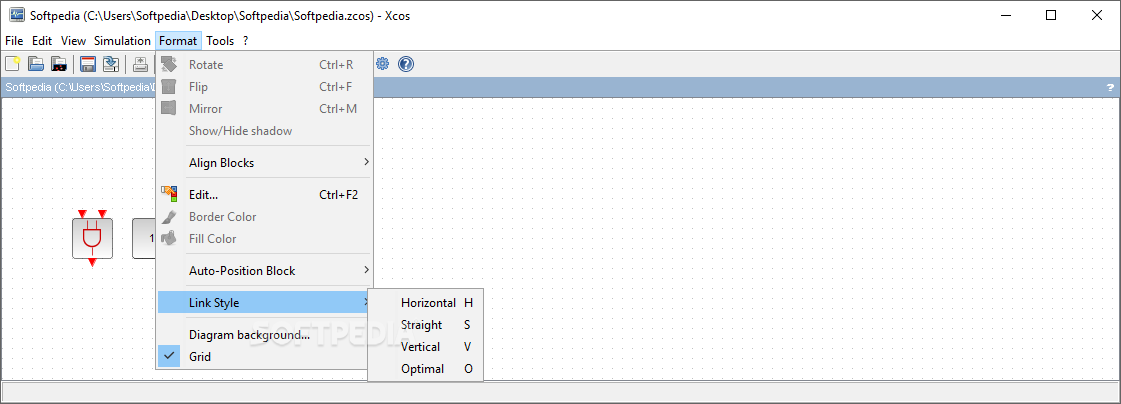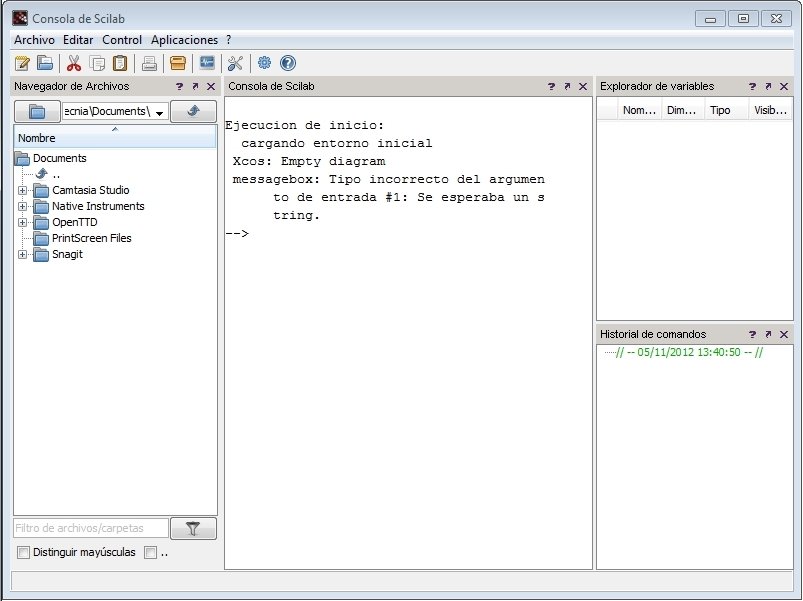| Developer(s) | ESI Group |
|---|---|
| Stable release | 6.1.0[1] / 25 February 2020; 13 months ago |
| Repository | |
| Written in | Scilab, C, C++, Java, Fortran |
| Operating system | BSDs (e.g., FreeBSD), Linux, macOS, Windows |
| Available in | English, German, Spanish, French, Italian, Japanese, Portuguese (Brazil), Russian, Ukrainian, Chinese, Czech, Polish |
| Type | Technical computing |
| License | GPLv2, previously CeCILL |
| Website | www.scilab.org |
- Download Scilab 6.0.2 Scilab is a free open source software for scientific modeling and simulation. It is a cross-platform software running on Windows, Linux, and macOS. It resembles many aspects of MATLAB with many built-in functions and tools to facilitate the modeling of natural and human systems.
- Scilab is a free and open-source, cross-platform numerical computational package and a high-level, numerically oriented programming language.It can be used for signal processing, statistical analysis, image enhancement, fluid dynamics simulations, numerical optimization, and modeling, simulation of explicit and implicit dynamical systems and (if the corresponding toolbox is installed) symbolic.
Scilab is a free and open-source, cross-platform numerical computational package and a high-level, numerically oriented programming language. Itcan be used for signal processing, statistical analysis, image enhancement, fluid dynamics simulations, numerical optimization, and modeling, simulation of explicit and implicit dynamical systems and (if the corresponding toolbox is installed) symbolic manipulations.
Source: tubeup.py. 8/10 (38 点) - 無料でScilabをダウンロード Scilabを利用すれば数学関数を含めることができる数値計算の実行に役立つツールですので是非とも利用してください.
Scilab is one of the two major open-source alternatives to MATLAB, the other one being GNU Octave.[2][3][4][5] Scilab puts less emphasis on syntactic compatibility with MATLAB than Octave does,[2][6][7] but it is similar enough that some authors suggest that it is easy to transfer skills between the two systems.[8]
Introduction[edit]
Scilab is a high-level, numerically oriented programming language. The language provides an interpreted programming environment, with matrices as the main data type. By using matrix-based computation, dynamic typing, and automatic memory management, many numerical problems may be expressed in a reduced number of code lines, as compared to similar solutions using traditional languages, such as Fortran, C, or C++. This allows users to rapidly construct models for a range of mathematical problems. While the language provides simple matrix operations such as multiplication, the Scilab package also provides a library of high-level operations such as correlation and complex multidimensional arithmetic. The software can be used for signal processing, statistical analysis, image enhancement, fluid dynamics simulations, and numerical optimization.[9][10][11]
Scilab also includes a free package called Xcos (a fork of Scicos based on Modelica language) for modeling and simulation of explicit and implicit dynamical systems, including both continuous and discrete sub-systems. Xcos is the open source equivalent to Simulink from the MathWorks.
As the syntax of Scilab is similar to MATLAB, Scilab includes a source code translator for assisting the conversion of code from MATLAB to Scilab. Scilab is available free of cost under an open source license. Due to the open source nature of the software, some user contributions have been integrated into the main program.
Syntax[edit]
Scilab syntax is largely based on the MATLAB language. The simplest way to execute Scilab code is to type it in at the prompt, --> , in the graphical command window. In this way, Scilab can be used as an interactive mathematical shell.
Hello World! in Scilab:
Plotting a 3D surface function:
Toolboxes[edit]
Scilab has many contributed toolboxes for different tasks, such as
- Scilab Image Processing Toolbox (SIP) and its variants (such as SIVP)
- Scilab Wavelet Toolbox
- Scilab Java and .NET Module
- Scilab Remote Access Module
More are available on ATOMS Portal or the Scilab forge.
History[edit]
Scilab was created in 1990 by researchers from INRIA and École nationale des ponts et chaussées (ENPC). It was initially named Ψlab[12](Psilab). The Scilab Consortium was formed in May 2003 to broaden contributions and promote Scilab as worldwide reference software in academia and industry.[13] In July 2008, in order to improve the technology transfer, the Scilab Consortium joined the Digiteo Foundation.
Scilab 5.1, the first release compiled for Mac, was available in early 2009, and supported Mac OS X 10.5, a.k.a. Leopard. Thus, OSX 10.4, Tiger, was never supported except by porting from sources. Linux and Windows builds had been released since the beginning, with Solaris support dropped with version 3.1.1, and HP-UX dropped with version 4.1.2 after spotty support.
In June 2010, the Consortium announced the creation of Scilab Enterprises.[14] Scilab Enterprises develops and markets, directly or through an international network of affiliated services providers, a comprehensive set of services for Scilab users. Scilab Enterprises also develops and maintains the Scilab software. The ultimate goal of Scilab Enterprises is to help make the use of Scilab more effective and easy.
In February 2017 Scilab 6.0.0 was released which leveraged the latest C++ standards and lifted memory allocation limitations.
Since July 2012, Scilab is developed and published by Scilab Enterprises and in early 2017 Scilab Enterprises was acquired by Virtual Prototyping pioneer ESI Group[15]
Scilab Cloud App & Scilab Cloud API[edit]
Since 2016 Scilab can be embedded in a browser and be called via an interface written in Scilab or an API.
This new deployment method has the notable advantages of masking code & data as well as providing large computational power.[16]
See also[edit]
References[edit]
- ^https://www.scilab.org/download/6.1.0.
- ^ abThomas Trappenberg (2010). Fundamentals of Computational Neuroscience. Oxford University Press. p. 361. ISBN978-0-19-956841-3.
- ^A Muhammad; V Zalizniak (2011). Practical Scientific Computing. Woodhead Publishing. p. 3. ISBN978-0-85709-226-7.
- ^Bernard A. Megrey; Erlend Moksness (2008). Computers in Fisheries Research. Springer Science & Business Media. p. 345. ISBN978-1-4020-8636-6.
- ^Raul Raymond Kapuno (2008). Programming for Chemical Engineers Using C, C++, and MATLAB. Jones & Bartlett Publishers. p. 365. ISBN978-1-934015-09-4.
- ^Russell L. Herman (2013). A Course in Mathematical Methods for Physicists. CRC Press. p. 42. ISBN978-1-4665-8467-9.
- ^Alain Vande Wouwer; Philippe Saucez; Carlos Vilas (2014). Simulation of ODE/PDE Models with MATLAB®, OCTAVE and SCILAB: Scientific and Engineering Applications. Springer. pp. 114–115. ISBN978-3-319-06790-2.
- ^Mark A. Haidekker (2013). Linear Feedback Controls: The Essentials. Newnes. p. 3. ISBN978-0-12-405513-1.
- ^Holopainen, Timo (2000). 'Modelling and simulation of multitechnological machine systems'(PDF).
- ^Guenther, Raidl (May 1998). An improved genetic algorithm for the multiconstrained 0-1 knapsackproblem. Evolutionary Computation Proceedings. pp. 207–211. CiteSeerX10.1.1.20.6454. doi:10.1109/ICEC.1998.699502. ISBN978-0-7803-4869-1.
- ^Philippe., Roux (2016-03-29). Scilab : I. Fundamentals, from theory to practice. Paris, France. ISBN9782822702935. OCLC1003630046.
- ^'META2.3.1.1.html META2.3.1.1'.
- ^'SCILAB Consortium launched'. 2003.
- ^'SCILAB Enterprises announced'. 2010. Archived from the original on 2010-06-20.
- ^'Archived copy'. Archived from the original on 2017-08-24. Retrieved 2017-08-24.CS1 maint: archived copy as title (link)
- ^'Scilab Cloud'. Scilab.io. Retrieved 2017-10-08.
Further reading[edit]
- Stephen L. Campbell, Jean-Philippe Chancelier, Ramine Nikoukhah (2006). Modeling and Simulation in Scilab/Scicos. New York: Springer. ISBN978-0-387-27802-5.CS1 maint: uses authors parameter (link)
External links[edit]
| Wikimedia Commons has media related to Scilab. |
Scilab : A powerful calculus environment with the help of which a large variety of numerical calculations and expressions are easily solved
Since most research is done on a computer nowadays, various applications are available to aid with writing, calculations and design. Scilab is such an application and comes equipped with necessary tools to assure you that no mathematical function or expression is left unsolved.
Scilab 6.0 2 Tutorial
Install modules that suit your environment
By default, the application mostly handles basic calculations you input in a dedicated requirement field. However, accessing the module manager brings up another window that further widen possibilities.You manage to find an abundance of parent categories, like aerospace, data handling, education, numerical maths, technical and even processing. Nearly each category consists of multiple individual package that offer dedicated capabilities for what their name suggests.Perform advanced calculations and create schematics
In addition to its basic features, you are also able to take advantage of an integrated text editing utility. Accessing SciNotes brings up a simple window equipped with a text field and several dedicated functions.Furthermore, you can create schematics to use in other projects later on. A separate workspace allows you to place objects carefully aligned on a grid. These elements are easily selected from a list that ranges from but not limited to discontinuities, lookup tables, matrix, signal routing, annotations or demonstration blocks.Moreover, the application can also be used to design electrical schematics using the previously mentioned tool. Once your work is concluded, it can be saved to several application specific formats, as well as a few image types. For enhanced ease of access, you can easily import Matlab files by having them converted.To end with
Scilab 6.0.2 Download
Taking everything into consideration, we can say that Scilab is a powerful research tool on which you can rely for precision calculus. A little getting used to is required, seeing how most features are specialized, but it provides the expected result if managed correctly.
Conclusion
To conclude Scilab works on Windows operating system and can be easily downloaded using the below download link according to GPLv2 license. Scilab download file is only 171 MB in size.Scilab 6.1.0
Scilab was filed under the Science and Engineering category and was reviewed in softlookup.com and receive 4.5/5 Score.
Scilab has been tested by our team against viruses, spyware, adware, trojan, backdoors and was found to be 100% clean. We will recheck Scilab when updated to assure that it remains clean.

Scilab user Review
Scilab 6.0.2
Please review Scilab application and submit your comments below. We will collect all comments in an effort to determine whether the Scilab software is reliable, perform as expected and deliver the promised features and functionalities.Popularity 9/10 - Downloads - 135 - Score - 4.5/5
| Category: | Science and Engineering |
| Publisher: | Scilab Enterprises |
| Last Updated: | 7/22/2019 |
| Requirements: | Windows 10 64 bit / Windows 10 / Windows 8 64 bit / Windows 8 / Windows 7 64 bit / Windows 7 |
| License: | GPLv2 |
| Operating system: | Windows |
| Hits: | 452 |
| File size: | 171 MB |
| Price: | Not specified |

Scilab 6.0.1 64 Bit
| Leave A comment | |
| Name: * | E-Mail: * |
| Comment: * | |
Scilab 6.0.2
